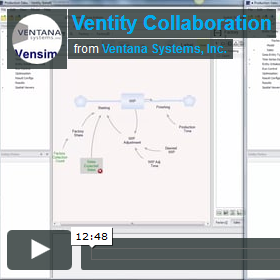Featured
Some features & applications of Ventity:
View More Featured Items-
Vensim Model Import
One of the newer features of our recent releases is the Vensim Model Import tool, and we’d like to take a few moments to walk through some of its uses and some tips for importing models from Vensim to Ventity. The first thing to keep in mind is that importing a Vensim model can only
-
Autocomplete

The Ventity equation editor, and other forms, are non-modal and use predictive typing. That makes it easy to navigate, view diagrams, and enter just what you need, without a complex dialog. Because a model has a limited set of terms, predictions are good, and model-diagram and units consistency checks further help to prevent errors.
-
Team Oriented Design

Ventity’s modular model format allows for multiple people to work on different parts of a model at the same time. This video shows some of the opportunities for team model building in Ventity.
News
We invite you to read about recent releases and other news:
View More News-
Ventity 5.2 Release
Feature Enhancements ·Sensitivity Analysis now uses parallel simulation which utilizes available processors to speed up the process ·Save Period to reduce size of output files and speed up processing ·Sensitivity Progress Window has been added to monitor the progress of a sensitivity run ·Style Sheets can now be used to change font sizes and colors
-
Ventity 5.1 Release
Ventity 5.1 adds new features including Run Lists, Style Overrides, and options to hide run-time warnings. This version also supports the use of entities created during the simulation by sensitivity and optimization parameters. See the help for more details.
-
What’s New @ ISDC 2024
Video from the Ventana Systems vendor demo/user group session at the 2024 System Dynamics conference in Bergen. See also: the new workshop video.
